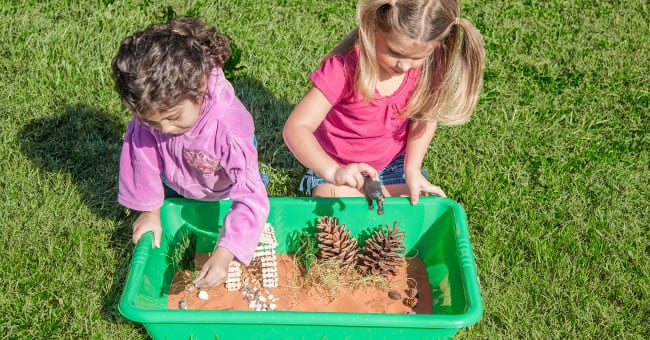
A lot of learning experiences in preschool, kindergarten, and elementary classrooms take place indoors, which many educational professionals say isn't always a good thing. Outdoor learning and play is a vital part of children's education and development and should be incorporated into lesson plans for students of all ages. NC State University's Natural Learning Initiative states in "Benefits of Connecting Children with Nature" that years of research documenting the advantages of connecting to nature have shown "that children's social, psychological, academic and physical health is positively impacted when they have daily contact with nature." A few of the positive effects mentioned in the article include increased physical activity, enhanced cognitive abilities, and improved nutrition, eyesight, and self-discipline.
Outdoor classrooms and learning environments should be as natural as possible and include engaging and exciting activity stations for children. The types of activities and educational subjects you incorporate into the outdoor learning environment will be mostly dependent on the ages of the children using the space. Here are a few ideas of subjects you should incorporate into your outdoor classroom for both younger and older children:
Math
A math station is a must-have for outdoor classrooms. Use natural objects, such as acorns, leaves, pebbles, and sticks, and outdoor accessory kits for activities that encourage younger children to learn how to count, add, subtract, and recognize shapes. Natural objects and outdoor sets can also be used to help teach older children how to do more advanced mathematics. You can even create word problems based on the animals and objects in your outdoor classroom.
Art
An art station in an outdoor learning space fosters creativity and critical thinking. Children of all ages will enjoy creating works of art with natural objects or a variety of art supplies. Encourage them to draw pictures in the dirt with a stick or use an outdoor easel to draw or paint the animals and plants they see in the space. Sidewalk chalk is another great art alternative for helping kids get creative in their outdoor classroom.
Science
You can't have an outdoor classroom or learning environment without incorporating science in some way. There are a variety of science activities and topics children will enjoy learning about outside, including weather and climate, plants and animals, and light and shadow. Be sure your outdoor science center has a thermometer, rain gauge, and bird feeder among other items you think the children in your care will enjoy. An outdoor sand and water table is also a good item to include in an outdoor classroom. A garden for children to plant flowers, herbs, and plants in is another must-have. Whether you plant a natural garden or use a planting kit, such as Earth Box Early Site Pack or Ready to Grow Base Kit, children will love learning about and being a part of the gardening process.
Literacy
An outdoor classroom is a great place for children to learn new vocabulary words and to document their learning experiences. Place sticky notes or tape note cards with new vocabulary words that correspond to objects in the outdoor classroom around the space. This will help children learn new words faster and associate them with a variety of learning experiences. Being in an outdoor learning environment can also foster creative writing. Encourage kids to write about their surroundings and what they see happening in the outdoor classroom. Reading is another literacy activity children of all ages can enjoy in the outdoor classroom. Place blankets, chairs, and outdoor pillows in the space to encourage kids to enjoy a good book and soak up the sunshine.
Sensory Play
Sensory play activities are great to include in your outdoor classroom for younger children, but older children can also benefit from them. Getting older children out of the classroom and having them observe and touch the plants, rocks, and other items they are learning about in class will help them gain knowledge from experience. Be sure to provide a variety of materials, tools, and nature items in your outdoor classroom to help kids explore texture, patterns, sight, and sound. A magnifying glass, for example, can give children an up-close view of a plant's leaves.
Dramatic Play
Dramatic play activities are also good to include in outdoor learning environments for younger children. Encourage kids to dress up as outdoor explorers and investigate different areas in the outdoor classroom. Other dramatic play ideas include dressing up as a scientist, meteorologist, artist, or construction worker.
Once you've figured out what you want to include in the space, the next step is to finalize the size and location of the outdoor classroom. The ages of the children using the outdoor classroom and how many children are using it will determine the size and location. You'll probably have a smaller outdoor classroom if it's just your class using it, but an outdoor classroom that is used by several classes or an entire school needs to be larger and in a central location.
For more information about outdoor classrooms and learning environments, browse through our selection of materials below.
